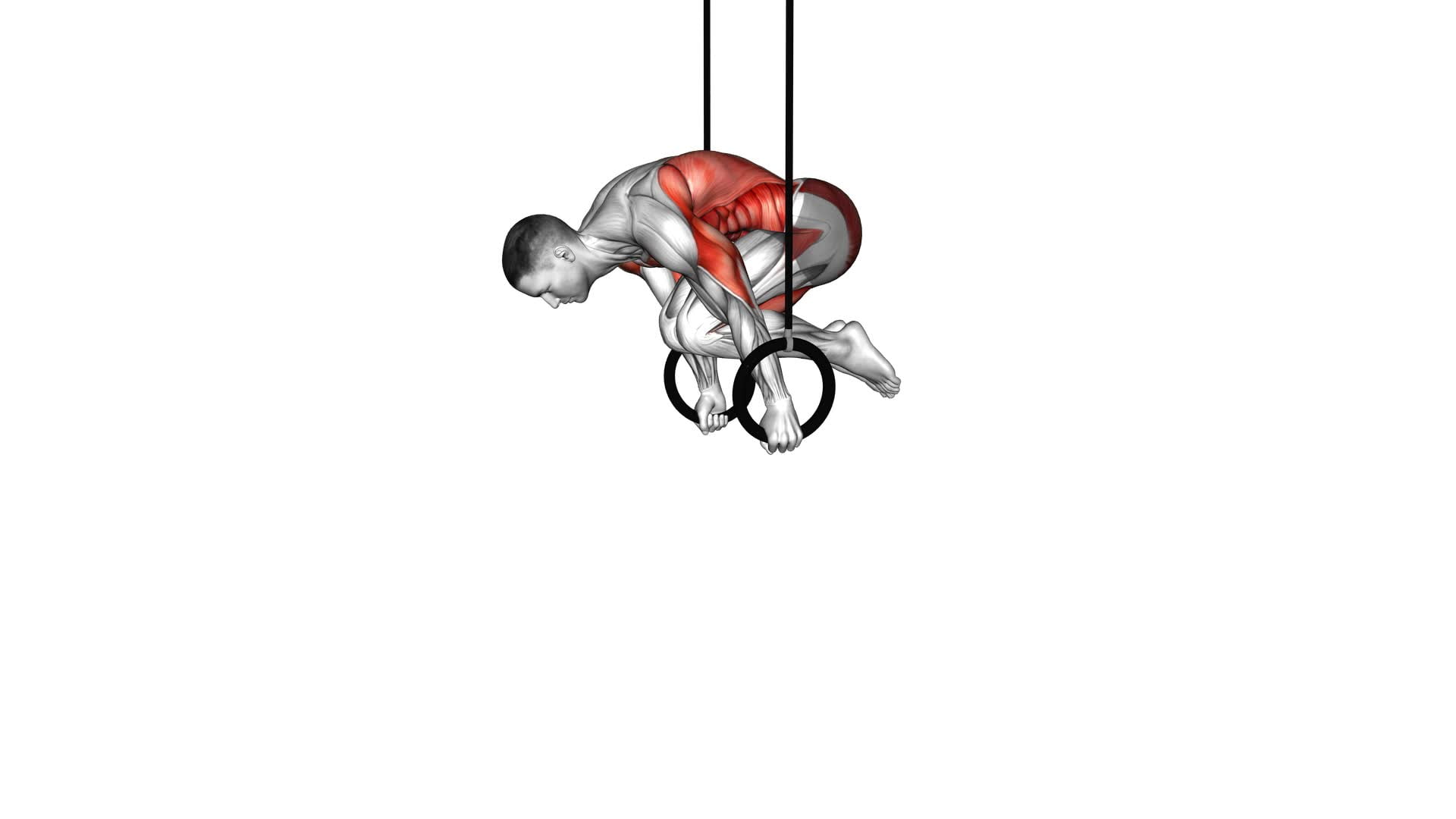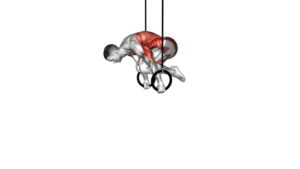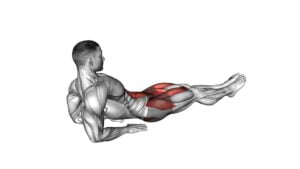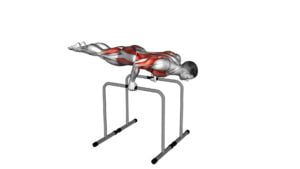Ring Tuck Planche (male) – Video Exercise Guide & Tips

Looking to strengthen your core and build impressive upper body strength? The Ring Tuck Planche is the exercise for you.
Watch This Exercise Video
In this video exercise guide, we'll show you the proper form and technique, as well as provide progression exercises for beginners and advanced variations for experienced athletes.
Avoid common mistakes and master this challenging move with our tips.
Get ready to take your fitness to the next level with the Ring Tuck Planche.
Key Takeaways
- The Ring Tuck Planche strengthens core muscles and improves shoulder stability.
- Proper form and technique include positioning hands slightly wider than shoulder-width apart, tucking knees in towards the chest, and keeping the body parallel to the ground.
- Beginners can start with tuck planche holds on the floor or on parallettes/rings, and gradually increase the difficulty of exercises to build strength in the shoulders, wrists, and core muscles.
- Advanced variations for experienced athletes include the single leg ring tuck planche, back lever pulls, and ring handstand push-ups, which challenge strength, balance, and control.
Benefits of the Ring Tuck Planche
One benefit of the Ring Tuck Planche is that it strengthens your core muscles. This exercise is great for improving strength and developing shoulder stability.
The Ring Tuck Planche requires you to hold your body in a horizontal position with your hands on rings and your legs tucked in towards your chest. As you hold this position, your core muscles, including your abdominals and lower back, have to work hard to stabilize your body and maintain balance. This not only helps to build strength in your core, but also improves your overall stability and control.
Additionally, the Ring Tuck Planche challenges your shoulder muscles, including your deltoids and trapezius, as they've to support your body weight and keep your upper body elevated.
Proper Form and Technique
To perform the Ring Tuck Planche with proper form and technique, you should begin by positioning your hands on the rings and tucking your legs in towards your chest. Ensuring proper form is of utmost importance when performing this exercise to avoid any potential shoulder strain.
When starting the Ring Tuck Planche, make sure your hands are positioned slightly wider than shoulder-width apart on the rings. This will provide you with a stable base to support your bodyweight. Engage your core muscles and lift your feet off the ground, tucking your knees in towards your chest.
As you lift your feet, focus on keeping your body parallel to the ground. Your arms should be straight and your shoulders should be pushed down and away from your ears. This will help to distribute the weight evenly and reduce strain on your shoulders.
Maintain this position for the desired duration, making sure to breathe steadily throughout the exercise. It's important to note that proper form is crucial for the effectiveness of the Ring Tuck Planche and to prevent any unnecessary strain on your shoulders.
Progression Exercises for Beginners
What are some beginner progression exercises for the Ring Tuck Planche?
If you're just starting out with the Ring Tuck Planche, there are several exercises you can incorporate into your training to help you progress towards achieving this challenging move. One important tip for beginners is to focus on building strength in your shoulders, wrists, and core muscles.
A good starting exercise is the tuck planche hold on the floor, where you tuck your knees into your chest and try to hold the position for as long as possible. As you become more comfortable with this exercise, you can progress to the tuck planche on parallettes or rings, which adds an extra challenge to your stability and balance.
Another helpful exercise is the tuck planche push-up, where you start in the tuck planche position and then lower yourself down into a push-up before pushing back up. This exercise not only works your upper body, but also helps to improve your control and balance in the tuck planche position.
By consistently practicing these progression exercises and gradually increasing the difficulty, you'll be well on your way to mastering the Ring Tuck Planche.
Now that you have a solid foundation with the beginner progression exercises, let's move on to the advanced variations for experienced athletes.
Advanced Variations for Experienced Athletes
Now that you've mastered the basic progression exercises, it's time to challenge yourself with advanced variations.
These progressions are designed for experienced athletes who are looking to take their bodyweight training to the next level.
By mastering advanced bodyweight exercises like the ring tuck planche, you can push your strength, balance, and control to new heights.
Here are some tips to help you acquire these advanced skills efficiently and effectively.
Challenging Progressions for Athletes
Start by incorporating more challenging variations into your workouts to push yourself as an experienced athlete. Here are some advanced variations and challenging progressions that will take your training to the next level:
- Single Leg Ring Tuck Planche: This variation requires you to perform the tuck planche while keeping one leg extended straight out in front of you, adding an extra level of difficulty and balance.
- Back Lever Pulls: Combine the strength of the back lever with the pulling motion of a row by pulling your body up towards the rings while maintaining the lever position.
- Ring Handstand Push-Ups: Once you have mastered the standard handstand push-up, challenge yourself by performing them on the rings, which adds instability and increases the demand on your shoulders and core.
By incorporating these challenging progressions and advanced variations into your workouts, you'll continue to push your limits and improve your strength and skill.
Now, let's move on to the next section and discuss mastering advanced bodyweight exercises.
Mastering Advanced Bodyweight Exercises
To level up your training as an experienced athlete, incorporate advanced variations of bodyweight exercises to challenge yourself further. Advanced bodyweight training is a great way to continue building strength, improving flexibility, and enhancing overall athleticism. These exercises require a high level of skill development and can take your fitness journey to the next level.
Whether it's mastering the planche, handstand push-ups, or one-arm push-ups, advanced bodyweight exercises push your limits and test your abilities. They require a strong core, excellent balance, and exceptional body control. By incorporating these challenging variations into your training routine, you can continue to challenge yourself, breaking through plateaus and achieving new levels of athleticism.
Keep pushing your boundaries and exploring advanced bodyweight training to continue progressing in your fitness journey.
Tips for Advanced Skill Acquisition
As an experienced athlete looking to further challenge yourself in advanced bodyweight training, you can continue to push your boundaries and enhance your skills with advanced variations for experienced athletes.
Here are some effective training strategies for advanced skill development:
- Progressive Overload: Gradually increase the difficulty of your exercises by adding more resistance, using unstable surfaces, or reducing leverage.
- Specificity and Variation: Focus on exercises that closely mimic the movements and demands of your target skill, while also incorporating variations to challenge different aspects of your strength and stability.
- Smart Programming: Design a well-structured training program that includes proper warm-up, targeted skill practice, strength training, and adequate rest and recovery.
Common Mistakes to Avoid
When performing the ring tuck planche, it's essential to maintain proper form to avoid injury and maximize effectiveness.
One common mistake to avoid is placing too much strain on your shoulders by not properly engaging your core.
To prevent this, focus on maintaining a strong, stable core throughout the exercise.
Proper Form Importance
Focus on maintaining proper form to maximize the benefits of the Ring Tuck Planche exercise and avoid common mistakes. Proper form is crucial for achieving the full potential of this challenging exercise. Here are some key benefits of proper form and common form mistakes to avoid:
- Benefits of proper form:
- Increased stability and balance: Maintaining proper form ensures that your body is in the correct alignment, enhancing stability and balance during the exercise.
- Targeted muscle engagement: Proper form allows for optimal muscle activation, targeting the intended muscles, such as the core, shoulders, and triceps.
- Injury prevention: By following proper form, you reduce the risk of injury and strain on joints and muscles.
- Common form mistakes to avoid:
- Rounded back: Keep your back straight and avoid rounding your shoulders to maintain a proper posture.
- Sagging hips: Engage your core muscles to prevent your hips from dropping, which can compromise the effectiveness of the exercise.
- Lack of control: Maintain control throughout the movement and avoid rushing or using momentum to perform the Ring Tuck Planche.
Avoiding Shoulder Strain
To prevent shoulder strain and reduce the risk of injury, maintain proper form and avoid these common mistakes while performing the Ring Tuck Planche exercise.
First, don't let your shoulders roll forward or hunch up towards your ears. This puts unnecessary strain on the shoulder joints and increases the risk of injury. Instead, focus on retracting and depressing your shoulder blades to engage the muscles in your upper back.
Additionally, avoid allowing your elbows to flare out to the sides. This can strain the rotator cuff muscles in your shoulders. Keep your elbows tucked in towards your body to maintain proper alignment and distribute the load evenly.
Core Engagement Tips
Maintain proper core engagement to avoid common mistakes while performing the Ring Tuck Planche exercise. Core engagement is crucial for stability and strength building during this challenging movement. Here are some tips to help you engage your core effectively:
- Imagine pulling your belly button towards your spine, creating a strong contraction in your abdominal muscles.
- Focus on keeping your core tight throughout the entire exercise, as this will help you maintain balance and control.
- Remember to breathe deeply and evenly, as holding your breath can cause unnecessary tension and hinder your performance.
Tips for Mastering the Ring Tuck Planche
To improve your mastery of the Ring Tuck Planche, focus on developing your core strength and stability. One of the most common mistakes people make when attempting this exercise isn't engaging their core properly. To avoid this mistake, make sure to actively contract your abdominal muscles throughout the entire movement. This will help you maintain control and stability while balancing on the rings.
Another key tip for mastering the Ring Tuck Planche is to gradually progress in difficulty. Start by practicing the exercise with bent knees, gradually working towards straightening your legs over time. This will allow your body to adapt to the demands of the exercise and build the necessary strength and stability.
Additionally, it's important to maintain proper form during the Ring Tuck Planche. Keep your shoulders and hips in line and your back straight. Avoid rounding your back or letting your shoulders collapse forward, as this can compromise your stability and increase the risk of injury.
Remember to be patient and consistent in your training. Mastering the Ring Tuck Planche takes time and practice. By focusing on core engagement, progressing gradually, and maintaining proper form, you'll be on your way to achieving this challenging exercise.
Frequently Asked Questions
How Long Does It Take to Master the Ring Tuck Planche?
Mastering the ring tuck planche may vary depending on your individual progress and dedication. However, by following proper ring tuck planche progressions and consistently practicing, you can see improvements over time.
It's important to avoid common mistakes, such as not engaging your core or not maintaining proper body alignment. With regular practice and correct form, you can work towards mastering the ring tuck planche and achieve your fitness goals.
Can Women Also Perform the Ring Tuck Planche?
Women can definitely perform the ring tuck planche and experience its benefits.
This exercise helps strengthen the core, upper body, and shoulder muscles.
To modify the training for women, it's important to focus on building upper body and core strength through exercises like push-ups, planks, and dips.
Gradually progress to the ring tuck planche by starting with easier variations like tuck holds and gradually extending the legs.
Consistency and proper form are key for success in this challenging exercise.
What Muscles Are Primarily Targeted During the Ring Tuck Planche?
During the ring tuck planche, several muscles are primarily targeted. Your arms and shoulders work hard to support your body weight, while your core muscles engage to maintain stability. Additionally, your chest, triceps, and upper back muscles are activated to help you maintain the proper position.
Performing the ring tuck planche regularly can improve your upper body strength and stability, as well as enhance your overall body control and coordination.
Are There Any Specific Warm-Up Exercises Recommended Before Attempting the Ring Tuck Planche?
Before attempting the ring tuck planche, it's important to warm up your muscles properly. Incorporating specific warm-up exercises into your routine can help prepare your body for this challenging exercise. These exercises could include dynamic stretches, shoulder and wrist mobility exercises, and core activation movements. Warming up effectively can help prevent injuries and improve your performance during the ring tuck planche.
Additionally, the ring tuck planche offers numerous benefits. It strengthens your core, shoulders, and upper body muscles, improves balance, and enhances overall body control.
Can the Ring Tuck Planche Help Improve Other Upper Body Exercises, Such as Push-Ups or Handstands?
Incorporating ring training, like the ring tuck planche, into your upper body exercises can have several benefits. It can enhance your overall strength and stability, making exercises like push-ups and handstands more challenging and effective.
To master the ring tuck planche, you can start with progression exercises such as ring support holds and tuck planche leans. These exercises will help you build the necessary strength and control to eventually achieve the ring tuck planche.
Conclusion
In conclusion, the ring tuck planche is a challenging exercise that offers numerous benefits for strength and body control.
By following proper form and technique, beginners can progress through various exercises to build their skills.
Advanced athletes can explore advanced variations to further challenge themselves.
Avoiding common mistakes and following helpful tips will aid in mastering the ring tuck planche.
Incorporating this exercise into your fitness routine can lead to improved overall strength and athleticism.

Author
Years ago, the spark of my life’s passion ignited in my mind the moment I stepped into the local gym for the first time. The inaugural bead of perspiration, the initial endeavor, the very first surge of endorphins, and a sense of pride that washed over me post-workout marked the beginning of my deep-seated interest in strength sports, fitness, and sports nutrition. This very curiosity blossomed rapidly into a profound fascination, propelling me to earn a Master’s degree in Physical Education from the Academy of Physical Education in Krakow, followed by a Sports Manager diploma from the Jagiellonian University. My journey of growth led me to gain more specialized qualifications, such as being a certified personal trainer with a focus on sports dietetics, a lifeguard, and an instructor for wellness and corrective gymnastics. Theoretical knowledge paired seamlessly with practical experience, reinforcing my belief that the transformation of individuals under my guidance was also a reflection of my personal growth. This belief holds true even today. Each day, I strive to push the boundaries and explore new realms. These realms gently elevate me to greater heights. The unique combination of passion for my field and the continuous quest for growth fuels my drive to break new ground.







